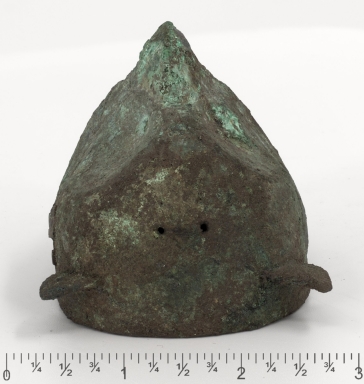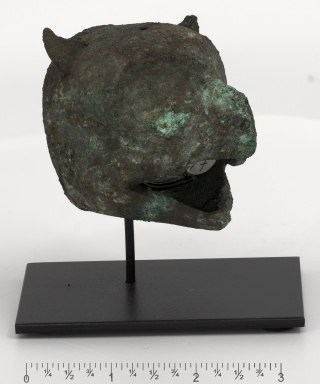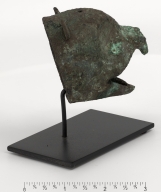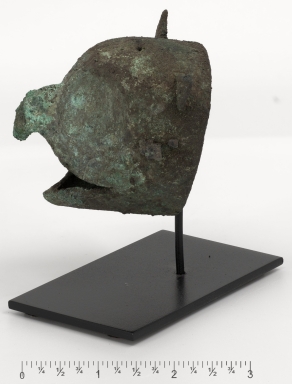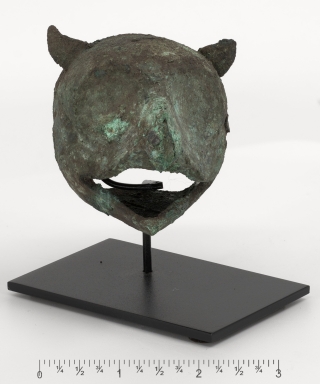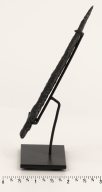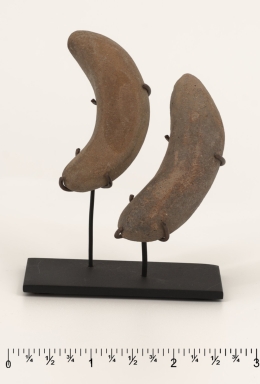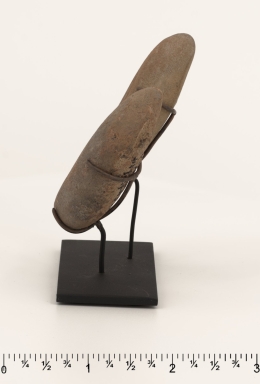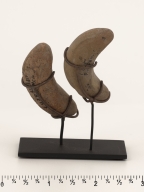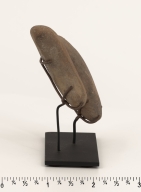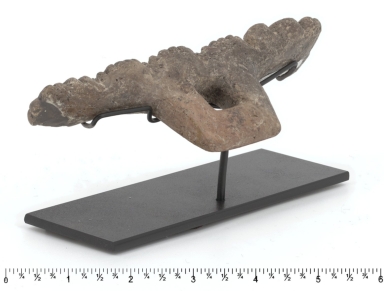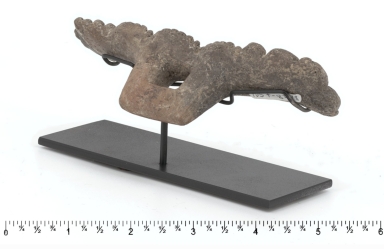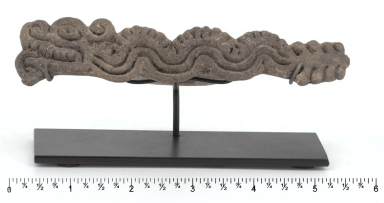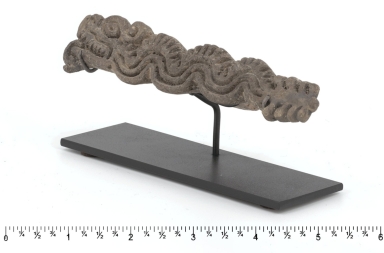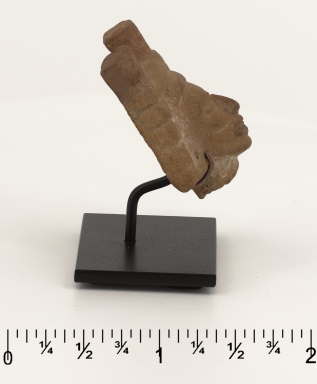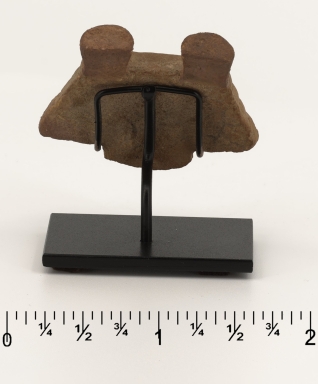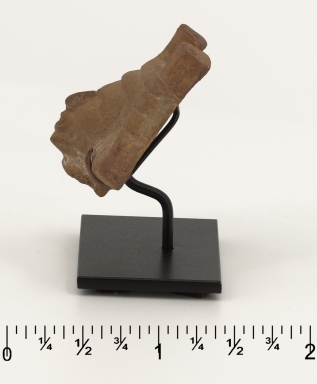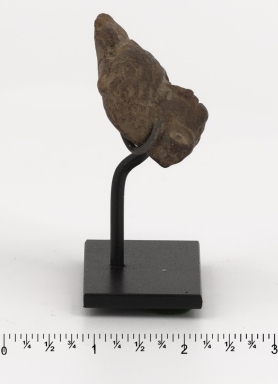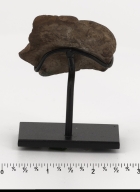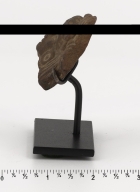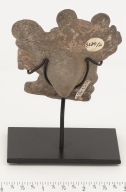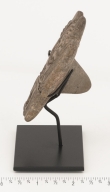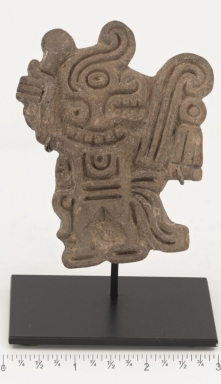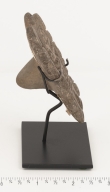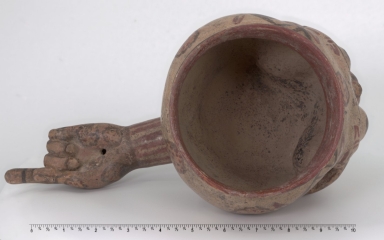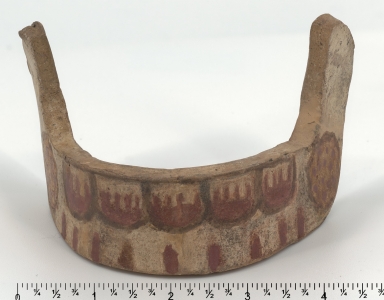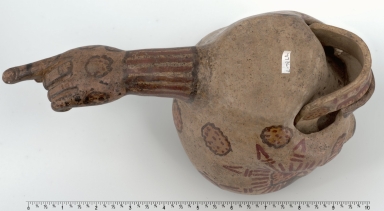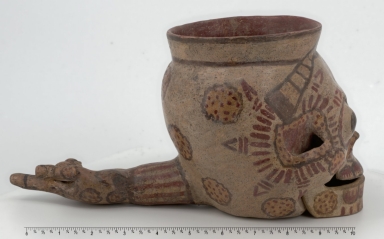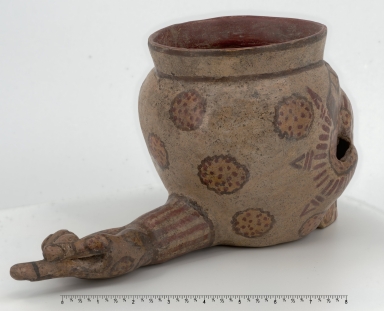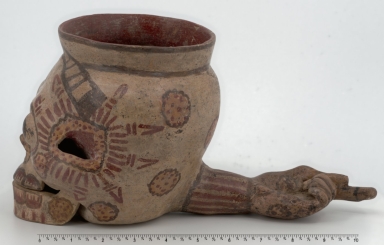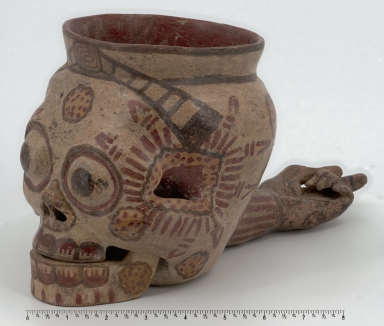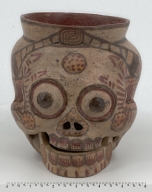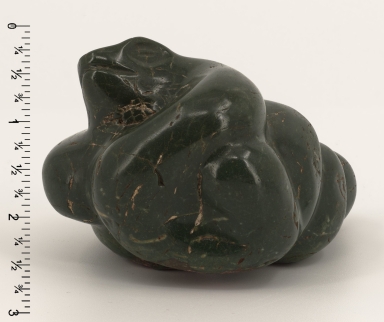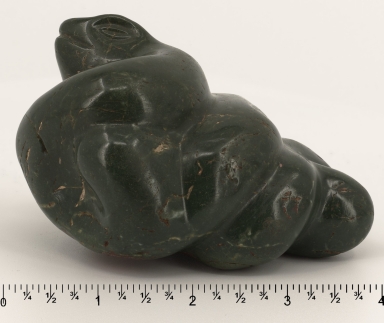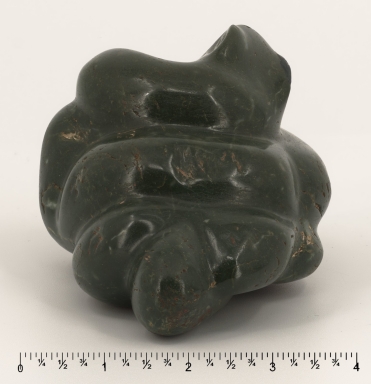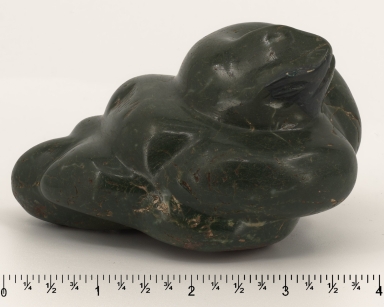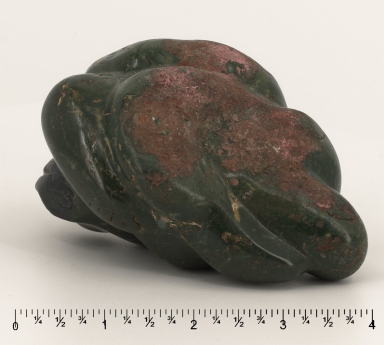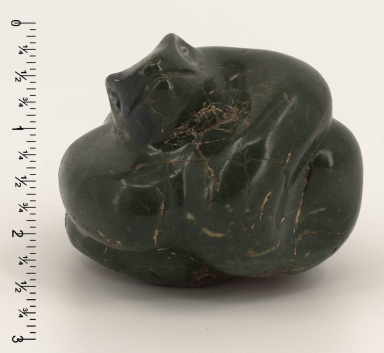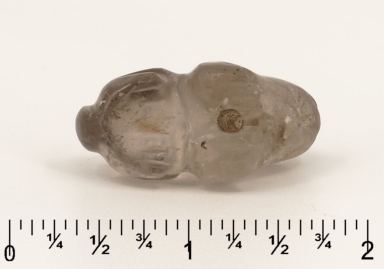|
REFINE
Browse All : Aztec art--Mexico and Indigenous peoples--Antiquities of MAW CollectionTitle
Owl Maskette
Description
This hollow, open-back copper maskette was cast using the lost-wax technique. The owl maskette was formed first in bees wax. The bees wax maskette was embedded in a super fine material such as clay. The clay and beeswax maskette was slowly heated melting out the bees wax and hardening the clay matrix. Molten metal was poured into the empty maskette are and cooled.
Subject
[Masks--Mexico, Aztec art--Mexico, Mixtec art--Antiquities, Purépecha art--Mexico, Indigenous peoples--Antiquities]
Date
between 900 and 1200
Title
Owl Maskette
Description
This hollow, open-back copper maskette was cast using the lost-wax technique. The owl maskette was formed first in bees wax. The bees wax maskette was embedded in a super fine material such as clay. The clay and beeswax maskette was slowly heated melting out the bees wax and hardening the clay matrix. Molten metal was poured into the empty maskette are and cooled.
Subject
[Masks--Mexico, Aztec art--Mexico, Mixtec art--Antiquities, Purépecha art--Mexico, Indigenous peoples--Antiquities]
Date
between 900 and 1200
Title
Owl Maskette
Description
This hollow, open-back copper maskette was cast using the lost-wax technique. The owl maskette was formed first in bees wax. The bees wax maskette was embedded in a super fine material such as clay. The clay and beeswax maskette was slowly heated melting out the bees wax and hardening the clay matrix. Molten metal was poured into the empty maskette are and cooled.
Subject
[Masks--Mexico, Aztec art--Mexico, Mixtec art--Antiquities, Purépecha art--Mexico, Indigenous peoples--Antiquities]
Date
between 900 and 1200
Title
Owl Maskette
Description
This hollow, open-back copper maskette was cast using the lost-wax technique. The owl maskette was formed first in bees wax. The bees wax maskette was embedded in a super fine material such as clay. The clay and beeswax maskette was slowly heated melting out the bees wax and hardening the clay matrix. Molten metal was poured into the empty maskette are and cooled.
Subject
[Masks--Mexico, Aztec art--Mexico, Mixtec art--Antiquities, Purépecha art--Mexico, Indigenous peoples--Antiquities]
Date
between 900 and 1200
Title
Owl Maskette
Description
This hollow, open-back copper maskette was cast using the lost-wax technique. The owl maskette was formed first in bees wax. The bees wax maskette was embedded in a super fine material such as clay. The clay and beeswax maskette was slowly heated melting out the bees wax and hardening the clay matrix. Molten metal was poured into the empty maskette are and cooled.
Subject
[Masks--Mexico, Aztec art--Mexico, Mixtec art--Antiquities, Purépecha art--Mexico, Indigenous peoples--Antiquities]
Date
between 900 and 1200
Title
Owl Maskette
Description
This hollow, open-back copper maskette was cast using the lost-wax technique. The owl maskette was formed first in bees wax. The bees wax maskette was embedded in a super fine material such as clay. The clay and beeswax maskette was slowly heated melting out the bees wax and hardening the clay matrix. Molten metal was poured into the empty maskette are and cooled.
Subject
[Masks--Mexico, Aztec art--Mexico, Mixtec art--Antiquities, Purépecha art--Mexico, Indigenous peoples--Antiquities]
Date
between 900 and 1200
Title
Owl Maskette
Description
This hollow, open-back copper maskette was cast using the lost-wax technique. The owl maskette was formed first in bees wax. The bees wax maskette was embedded in a super fine material such as clay. The clay and beeswax maskette was slowly heated melting out the bees wax and hardening the clay matrix. Molten metal was poured into the empty maskette are and cooled.
Subject
[Masks--Mexico, Aztec art--Mexico, Mixtec art--Antiquities, Purépecha art--Mexico, Indigenous peoples--Antiquities]
Date
between 900 and 1200
Title
Aztec obsidian piercer.
Description
Volcanic glass or obsidian has been knapped to form a long hilted object. This piercer could be used in auto-sacrifice to cause blood to flow. Obsidian cuts flesh without tearing it.
Subject
[Spears--Mexico, Weapons--Mexico, Aztec art--Mexico, Indigenous peoples--Antiquities]
Date
between 900 and 1521
Title
Aztec obsidian piercer.
Description
Volcanic glass or obsidian has been knapped to form a long hilted object. This piercer could be used in auto-sacrifice to cause blood to flow. Obsidian cuts flesh without tearing it.
Subject
[Spears--Mexico, Weapons--Mexico, Aztec art--Mexico, Indigenous peoples--Antiquities]
Date
between 900 and 1521
Title
Aztec obsidian piercer.
Description
Volcanic glass or obsidian has been knapped to form a long hilted object. This piercer could be used in auto-sacrifice to cause blood to flow. Obsidian cuts flesh without tearing it.
Subject
[Spears--Mexico, Weapons--Mexico, Aztec art--Mexico, Indigenous peoples--Antiquities]
Date
between 900 and 1521
Title
Aztec obsidian piercer.
Description
Volcanic glass or obsidian has been knapped to form a long hilted object. This piercer could be used in auto-sacrifice to cause blood to flow. Obsidian cuts flesh without tearing it.
Subject
[Spears--Mexico, Weapons--Mexico, Aztec art--Mexico, Indigenous peoples--Antiquities]
Date
between 900 and 1521
Title
Aztec, Mexica ear plugs : banana form.
Description
This non-matching pair of plugs represent a different style of body adornment used by the non-elite. They came in different sizes and shapes suitable to the wearer. The banana plug was worn by the Aztec and the Gulf Coast Huastec. It is possible they could be nose ornaments or ear plugs.
Subject
[Decoration and ornament--Mexico, Ceramic jewelry--Mexico, Aztec art--Mexico, Indigenous peoples--Antiquities]
Date
between 1200 and 1521
Title
Aztec, Mexica ear plugs : banana form.
Description
This non-matching pair of plugs represent a different style of body adornment used by the non-elite. They came in different sizes and shapes suitable to the wearer. The banana plug was worn by the Aztec and the Gulf Coast Huastec. It is possible they could be nose ornaments or ear plugs.
Subject
[Decoration and ornament--Mexico, Ceramic jewelry--Mexico, Aztec art--Mexico, Indigenous peoples--Antiquities]
Date
between 1200 and 1521
Title
Aztec, Mexica ear plugs : banana form.
Description
This non-matching pair of plugs represent a different style of body adornment used by the non-elite. They came in different sizes and shapes suitable to the wearer. The banana plug was worn by the Aztec and the Gulf Coast Huastec. It is possible they could be nose ornaments or ear plugs.
Subject
[Decoration and ornament--Mexico, Ceramic jewelry--Mexico, Aztec art--Mexico, Indigenous peoples--Antiquities]
Date
between 1200 and 1521
Title
Aztec, Mexica ear plugs : banana form.
Description
This non-matching pair of plugs represent a different style of body adornment used by the non-elite. They came in different sizes and shapes suitable to the wearer. The banana plug was worn by the Aztec and the Gulf Coast Huastec. It is possible they could be nose ornaments or ear plugs.
Subject
[Decoration and ornament--Mexico, Ceramic jewelry--Mexico, Aztec art--Mexico, Indigenous peoples--Antiquities]
Date
between 1200 and 1521
Title
Aztec body stamp : undulating serpent.
Description
A brownware stamp features a plumed undulating rattlesnake. Post Classic Aztec myth speaks of his forceful breath which caused the newly created sun to move. His name is Ehecatl-Quetzalcoatl, the plumed serpent of wind, rain, and agricultural fertility.
Subject
[Aztec sculpture--Mexico, Ceramic sculpture--Mexico, Aztec art--Mexico, Indigenous peoples--Antiquities]
Date
between 1200 and 1521
Title
Aztec body stamp : undulating serpent.
Description
A brownware stamp features a plumed undulating rattlesnake. Post Classic Aztec myth speaks of his forceful breath which caused the newly created sun to move. His name is Ehecatl-Quetzalcoatl, the plumed serpent of wind, rain, and agricultural fertility.
Subject
[Aztec sculpture--Mexico, Ceramic sculpture--Mexico, Aztec art--Mexico, Indigenous peoples--Antiquities]
Date
between 1200 and 1521
Title
Aztec body stamp : undulating serpent.
Description
A brownware stamp features a plumed undulating rattlesnake. Post Classic Aztec myth speaks of his forceful breath which caused the newly created sun to move. His name is Ehecatl-Quetzalcoatl, the plumed serpent of wind, rain, and agricultural fertility.
Subject
[Aztec sculpture--Mexico, Ceramic sculpture--Mexico, Aztec art--Mexico, Indigenous peoples--Antiquities]
Date
between 1200 and 1521
Title
Aztec body stamp : undulating serpent.
Description
A brownware stamp features a plumed undulating rattlesnake. Post Classic Aztec myth speaks of his forceful breath which caused the newly created sun to move. His name is Ehecatl-Quetzalcoatl, the plumed serpent of wind, rain, and agricultural fertility.
Subject
[Aztec sculpture--Mexico, Ceramic sculpture--Mexico, Aztec art--Mexico, Indigenous peoples--Antiquities]
Date
between 1200 and 1521
Title
Aztec body stamp : undulating serpent.
Description
A brownware stamp features a plumed undulating rattlesnake. Post Classic Aztec myth speaks of his forceful breath which caused the newly created sun to move. His name is Ehecatl-Quetzalcoatl, the plumed serpent of wind, rain, and agricultural fertility.
Subject
[Aztec sculpture--Mexico, Ceramic sculpture--Mexico, Aztec art--Mexico, Indigenous peoples--Antiquities]
Date
between 1200 and 1521
Title
Aztec head from a mold-made figure.
Description
Elaborate twisted hairdo: knotted on top. Female? Concentrations of broken figurines (flat) in household context or debris rather than public buildings or temples suggest a personal or family context. the figurine called "ginger bread" flats, were manufactured by pressing wet clay into clay molds. They were removed for drying, firing, and painting. Fingerprints on the back.
Subject
[Aztec sculpture--Mexico, Ceramic sculpture--Mexico, Aztec art--Mexico, Indigenous peoples--Antiquities]
Date
between 600 and 1521
Title
Aztec head from a mold-made figure.
Description
Elaborate twisted hairdo: knotted on top. Female? Concentrations of broken figurines (flat) in household context or debris rather than public buildings or temples suggest a personal or family context. the figurine called "ginger bread" flats, were manufactured by pressing wet clay into clay molds. They were removed for drying, firing, and painting. Fingerprints on the back.
Subject
[Aztec sculpture--Mexico, Ceramic sculpture--Mexico, Aztec art--Mexico, Indigenous peoples--Antiquities]
Date
between 600 and 1521
Title
Aztec head from a mold-made figure.
Description
Elaborate twisted hairdo: knotted on top. Female? Concentrations of broken figurines (flat) in household context or debris rather than public buildings or temples suggest a personal or family context. the figurine called "ginger bread" flats, were manufactured by pressing wet clay into clay molds. They were removed for drying, firing, and painting. Fingerprints on the back.
Subject
[Aztec sculpture--Mexico, Ceramic sculpture--Mexico, Aztec art--Mexico, Indigenous peoples--Antiquities]
Date
between 600 and 1521
Title
Aztec head from a mold-made figure.
Description
Elaborate twisted hairdo: knotted on top. Female? Concentrations of broken figurines (flat) in household context or debris rather than public buildings or temples suggest a personal or family context. the figurine called "ginger bread" flats, were manufactured by pressing wet clay into clay molds. They were removed for drying, firing, and painting. Fingerprints on the back.
Subject
[Aztec sculpture--Mexico, Ceramic sculpture--Mexico, Aztec art--Mexico, Indigenous peoples--Antiquities]
Date
between 600 and 1521
Title
Aztec head from a mold-made figure.
Description
This incomplete figure was press molded. The orange clay, called orangeware, suggests mazapan ceramics. The flat gingerbread figure was a female holding a child and sometimes a small image of herself. She probably represents Precious Flower-Quetzalbird, Goddess of Flowers and Love. The Figure represents the commoners concern with fertility, health, and well-being. Note: Fingerprint present.
Subject
[Aztec sculpture--Mexico, Ceramic sculpture--Mexico, Aztec art--Mexico, Indigenous peoples--Antiquities]
Date
between 600 and 1521
Title
Aztec head from a mold-made figure.
Description
This incomplete figure was press molded. The orange clay, called orangeware, suggests mazapan ceramics. The flat gingerbread figure was a female holding a child and sometimes a small image of herself. She probably represents Precious Flower-Quetzalbird, Goddess of Flowers and Love. The Figure represents the commoners concern with fertility, health, and well-being. Note: Fingerprint present.
Subject
[Aztec sculpture--Mexico, Ceramic sculpture--Mexico, Aztec art--Mexico, Indigenous peoples--Antiquities]
Date
between 600 and 1521
Title
Aztec head from a mold-made figure.
Description
This incomplete figure was press molded. The orange clay, called orangeware, suggests mazapan ceramics. The flat gingerbread figure was a female holding a child and sometimes a small image of herself. She probably represents Precious Flower-Quetzalbird, Goddess of Flowers and Love. The Figure represents the commoners concern with fertility, health, and well-being. Note: Fingerprint present.
Subject
[Aztec sculpture--Mexico, Ceramic sculpture--Mexico, Aztec art--Mexico, Indigenous peoples--Antiquities]
Date
between 600 and 1521
Title
Aztec head from a mold-made figure.
Description
This incomplete figure was press molded. The orange clay, called orangeware, suggests mazapan ceramics. The flat gingerbread figure was a female holding a child and sometimes a small image of herself. She probably represents Precious Flower-Quetzalbird, Goddess of Flowers and Love. The Figure represents the commoners concern with fertility, health, and well-being. Note: Fingerprint present.
Subject
[Aztec sculpture--Mexico, Ceramic sculpture--Mexico, Aztec art--Mexico, Indigenous peoples--Antiquities]
Date
between 600 and 1521
Title
Aztec body stamp : monkey warrior.
Description
This anthropomorphic zoomorphic stamp illustrates a humanized monkey warrior, which carries a mace-like weapon and a shield. On his waist appears a longitudinal cross section of a shell, which can stand for Quetzalcoatl. The monkey image relates to Quetzalcoatl.
Subject
[Aztec sculpture--Mexico, Ceramic sculpture--Mexico, Aztec art--Mexico, Indigenous peoples--Antiquities]
Date
between 1200 and 1521
Title
Aztec body stamp : monkey warrior.
Description
This anthropomorphic zoomorphic stamp illustrates a humanized monkey warrior, which carries a mace-like weapon and a shield. On his waist appears a longitudinal cross section of a shell, which can stand for Quetzalcoatl. The monkey image relates to Quetzalcoatl.
Subject
[Aztec sculpture--Mexico, Ceramic sculpture--Mexico, Aztec art--Mexico, Indigenous peoples--Antiquities]
Date
between 1200 and 1521
Title
Aztec body stamp : monkey warrior.
Description
This anthropomorphic zoomorphic stamp illustrates a humanized monkey warrior, which carries a mace-like weapon and a shield. On his waist appears a longitudinal cross section of a shell, which can stand for Quetzalcoatl. The monkey image relates to Quetzalcoatl.
Subject
[Aztec sculpture--Mexico, Ceramic sculpture--Mexico, Aztec art--Mexico, Indigenous peoples--Antiquities]
Date
between 1200 and 1521
Title
Aztec body stamp : monkey warrior.
Description
This anthropomorphic zoomorphic stamp illustrates a humanized monkey warrior, which carries a mace-like weapon and a shield. On his waist appears a longitudinal cross section of a shell, which can stand for Quetzalcoatl. The monkey image relates to Quetzalcoatl.
Subject
[Aztec sculpture--Mexico, Ceramic sculpture--Mexico, Aztec art--Mexico, Indigenous peoples--Antiquities]
Date
between 1200 and 1521
Title
Aztec skull censer : articulable jaw one death.
Description
The censer's image combines a skull and a left arm with a predominate index figure. The index figure hand incorporates a rattle. The skull and figure can be read as "One Death". The skull has been painted with twenty-two marigold flowers and thirteen arrows, which all point to death.
Subject
[Aztec sculpture--Mexico, Ceramic censers--Mexico, Aztec art--Mexico, Indigenous peoples--Antiquities, Ceramic sculpture--Mexico]
Date
between 1325 and 1521
Title
Aztec skull censer : articulable jaw one death.
Description
The censer's image combines a skull and a left arm with a predominate index figure. The index figure hand incorporates a rattle. The skull and figure can be read as "One Death". The skull has been painted with twenty-two marigold flowers and thirteen arrows, which all point to death.
Subject
[Aztec sculpture--Mexico, Ceramic censers--Mexico, Aztec art--Mexico, Indigenous peoples--Antiquities, Ceramic sculpture--Mexico]
Date
between 1325 and 1521
Title
Aztec skull censer : articulable jaw one death.
Description
The censer's image combines a skull and a left arm with a predominate index figure. The index figure hand incorporates a rattle. The skull and figure can be read as "One Death". The skull has been painted with twenty-two marigold flowers and thirteen arrows, which all point to death.
Subject
[Aztec sculpture--Mexico, Ceramic censers--Mexico, Aztec art--Mexico, Indigenous peoples--Antiquities, Ceramic sculpture--Mexico]
Date
between 1325 and 1521
Title
Aztec skull censer : articulable jaw one death.
Description
The censer's image combines a skull and a left arm with a predominate index figure. The index figure hand incorporates a rattle. The skull and figure can be read as "One Death". The skull has been painted with twenty-two marigold flowers and thirteen arrows, which all point to death.
Subject
[Aztec sculpture--Mexico, Ceramic censers--Mexico, Aztec art--Mexico, Indigenous peoples--Antiquities, Ceramic sculpture--Mexico]
Date
between 1325 and 1521
Title
Aztec skull censer : articulable jaw one death.
Description
The censer's image combines a skull and a left arm with a predominate index figure. The index figure hand incorporates a rattle. The skull and figure can be read as "One Death". The skull has been painted with twenty-two marigold flowers and thirteen arrows, which all point to death.
Subject
[Aztec sculpture--Mexico, Ceramic censers--Mexico, Aztec art--Mexico, Indigenous peoples--Antiquities, Ceramic sculpture--Mexico]
Date
between 1325 and 1521
Title
Aztec skull censer : articulable jaw one death.
Description
The censer's image combines a skull and a left arm with a predominate index figure. The index figure hand incorporates a rattle. The skull and figure can be read as "One Death". The skull has been painted with twenty-two marigold flowers and thirteen arrows, which all point to death.
Subject
[Aztec sculpture--Mexico, Ceramic censers--Mexico, Aztec art--Mexico, Indigenous peoples--Antiquities, Ceramic sculpture--Mexico]
Date
between 1325 and 1521
Title
Aztec skull censer : articulable jaw one death.
Description
The censer's image combines a skull and a left arm with a predominate index figure. The index figure hand incorporates a rattle. The skull and figure can be read as "One Death". The skull has been painted with twenty-two marigold flowers and thirteen arrows, which all point to death.
Subject
[Aztec sculpture--Mexico, Ceramic censers--Mexico, Aztec art--Mexico, Indigenous peoples--Antiquities, Ceramic sculpture--Mexico]
Date
between 1325 and 1521
Title
Aztec skull censer : articulable jaw one death.
Description
The censer's image combines a skull and a left arm with a predominate index figure. The index figure hand incorporates a rattle. The skull and figure can be read as "One Death". The skull has been painted with twenty-two marigold flowers and thirteen arrows, which all point to death.
Subject
[Aztec sculpture--Mexico, Ceramic censers--Mexico, Aztec art--Mexico, Indigenous peoples--Antiquities, Ceramic sculpture--Mexico]
Date
between 1325 and 1521
Title
Aztec skull censer : articulable jaw one death.
Description
The censer's image combines a skull and a left arm with a predominate index figure. The index figure hand incorporates a rattle. The skull and figure can be read as "One Death". The skull has been painted with twenty-two marigold flowers and thirteen arrows, which all point to death.
Subject
[Aztec sculpture--Mexico, Ceramic censers--Mexico, Aztec art--Mexico, Indigenous peoples--Antiquities, Ceramic sculpture--Mexico]
Date
between 1325 and 1521
Title
Aztec skull censer : articulable jaw one death.
Description
The censer's image combines a skull and a left arm with a predominate index figure. The index figure hand incorporates a rattle. The skull and figure can be read as "One Death". The skull has been painted with twenty-two marigold flowers and thirteen arrows, which all point to death.
Subject
[Aztec sculpture--Mexico, Ceramic censers--Mexico, Aztec art--Mexico, Indigenous peoples--Antiquities, Ceramic sculpture--Mexico]
Date
between 1325 and 1521
Title
Aztec skull censer : articulable jaw one death.
Description
The censer's image combines a skull and a left arm with a predominate index figure. The index figure hand incorporates a rattle. The skull and figure can be read as "One Death". The skull has been painted with twenty-two marigold flowers and thirteen arrows, which all point to death.
Subject
[Aztec sculpture--Mexico, Ceramic censers--Mexico, Aztec art--Mexico, Indigenous peoples--Antiquities, Ceramic sculpture--Mexico]
Date
between 1325 and 1521
Title
Aztec greenstone coiled snake heart.
Description
A veined greenstone has been chipped, abraded, and polished to reveal a coiled predatory snake. A symbol of fertility, rebirth, and regeneration, the coils of the snake transform into the sacred heart, the precious symbol of life. The stone snake represents duality, life and death.
Subject
[Aztec sculpture--Mexico, Stone carving--Mexico, Snakes--Art, Aztec art--Mexico, Indigenous peoples--Antiquities]
Date
between 1470 and 1521
Title
Aztec greenstone coiled snake heart.
Description
A veined greenstone has been chipped, abraded, and polished to reveal a coiled predatory snake. A symbol of fertility, rebirth, and regeneration, the coils of the snake transform into the sacred heart, the precious symbol of life. The stone snake represents duality, life and death.
Subject
[Aztec sculpture--Mexico, Stone carving--Mexico, Snakes--Art, Aztec art--Mexico, Indigenous peoples--Antiquities]
Date
between 1470 and 1521
Title
Aztec greenstone coiled snake heart.
Description
A veined greenstone has been chipped, abraded, and polished to reveal a coiled predatory snake. A symbol of fertility, rebirth, and regeneration, the coils of the snake transform into the sacred heart, the precious symbol of life. The stone snake represents duality, life and death.
Subject
[Aztec sculpture--Mexico, Stone carving--Mexico, Snakes--Art, Aztec art--Mexico, Indigenous peoples--Antiquities]
Date
between 1470 and 1521
Title
Aztec greenstone coiled snake heart.
Description
A veined greenstone has been chipped, abraded, and polished to reveal a coiled predatory snake. A symbol of fertility, rebirth, and regeneration, the coils of the snake transform into the sacred heart, the precious symbol of life. The stone snake represents duality, life and death.
Subject
[Aztec sculpture--Mexico, Stone carving--Mexico, Snakes--Art, Aztec art--Mexico, Indigenous peoples--Antiquities]
Date
between 1470 and 1521
Title
Aztec greenstone coiled snake heart.
Description
A veined greenstone has been chipped, abraded, and polished to reveal a coiled predatory snake. A symbol of fertility, rebirth, and regeneration, the coils of the snake transform into the sacred heart, the precious symbol of life. The stone snake represents duality, life and death.
Subject
[Aztec sculpture--Mexico, Stone carving--Mexico, Snakes--Art, Aztec art--Mexico, Indigenous peoples--Antiquities]
Date
between 1470 and 1521
Title
Aztec greenstone coiled snake heart.
Description
A veined greenstone has been chipped, abraded, and polished to reveal a coiled predatory snake. A symbol of fertility, rebirth, and regeneration, the coils of the snake transform into the sacred heart, the precious symbol of life. The stone snake represents duality, life and death.
Subject
[Aztec sculpture--Mexico, Stone carving--Mexico, Snakes--Art, Aztec art--Mexico, Indigenous peoples--Antiquities]
Date
between 1470 and 1521
Title
Aztec quartz crystal rabbit pendant.
Description
According to Aztec mythology, the rabbit passed a group of Aztec gods as the second sun was resting at night. One of the gods grabbed the rabbit and pressed it against the second sun causing it to lose its heat and light. The decimated second sun became the rabbit in the moon.
Subject
[Pendants (Jewelry)--Mexico, Aztec sculpture--Mexico, Stone carving--Mexico, Aztec art--Mexico, Indigenous peoples--Antiquities]
Date
between 800 and 1521
|
